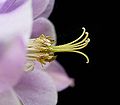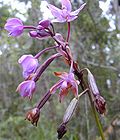Gynoecium
Gynoecium is the female reproductive part of a flower. It is composed of one or more carpels. The term "gynoecium" is derived from the Greek words "gyne" meaning woman and "oikos" meaning house. The gynoecium is often referred to as the "female house" as it houses the reproductive organs of the flower.
Structure[edit]
The gynoecium is typically located in the center of the flower and is surrounded by the androecium (male reproductive part) and the petals. The gynoecium can be composed of one or more carpels. Each carpel includes an ovary, a style, and a stigma.
Ovary[edit]
The ovary is the enlarged basal portion of the carpel. The ovary contains one or more ovules and will become the fruit after fertilization.
Style[edit]
The style is the long, slender stalk that connects the ovary and the stigma. The style is the pathway for pollen tubes to grow from the stigma to the ovules.
Stigma[edit]
The stigma is the receptive tip of the carpel, often sticky, where pollen grains adhere.
Function[edit]
The primary function of the gynoecium is to produce ovules and protect them until they are ready to be fertilized. Once fertilization occurs, the gynoecium develops into a fruit containing seeds.
See also[edit]
|
|
|
Gynoecium[edit]
-
Magnolia wieseneri - labelled gynoecium
-
Hippeastrum
-
Amaryllis stigma
-
Moss flowers
-
Mature flower diagram
-
Aquilegia vulgaris
-
Ranunculus repens - stamens and pistils closeup
-
Narcis zaadhokken
-
秋海棠
-
Spathoglottis flowers
-
Hegi ovary
-
Female squash
Ad. Transform your life with W8MD's Budget GLP-1 injections from $75


W8MD offers a medical weight loss program to lose weight in Philadelphia. Our physician-supervised medical weight loss provides:
- Weight loss injections in NYC (generic and brand names):
- Zepbound / Mounjaro, Wegovy / Ozempic, Saxenda
- Most insurances accepted or discounted self-pay rates. We will obtain insurance prior authorizations if needed.
- Generic GLP1 weight loss injections from $75 for the starting dose.
- Also offer prescription weight loss medications including Phentermine, Qsymia, Diethylpropion, Contrave etc.
NYC weight loss doctor appointmentsNYC weight loss doctor appointments
Start your NYC weight loss journey today at our NYC medical weight loss and Philadelphia medical weight loss clinics.
- Call 718-946-5500 to lose weight in NYC or for medical weight loss in Philadelphia 215-676-2334.
- Tags:NYC medical weight loss, Philadelphia lose weight Zepbound NYC, Budget GLP1 weight loss injections, Wegovy Philadelphia, Wegovy NYC, Philadelphia medical weight loss, Brookly weight loss and Wegovy NYC
|
WikiMD's Wellness Encyclopedia |
| Let Food Be Thy Medicine Medicine Thy Food - Hippocrates |
Medical Disclaimer: WikiMD is not a substitute for professional medical advice. The information on WikiMD is provided as an information resource only, may be incorrect, outdated or misleading, and is not to be used or relied on for any diagnostic or treatment purposes. Please consult your health care provider before making any healthcare decisions or for guidance about a specific medical condition. WikiMD expressly disclaims responsibility, and shall have no liability, for any damages, loss, injury, or liability whatsoever suffered as a result of your reliance on the information contained in this site. By visiting this site you agree to the foregoing terms and conditions, which may from time to time be changed or supplemented by WikiMD. If you do not agree to the foregoing terms and conditions, you should not enter or use this site. See full disclaimer.
Credits:Most images are courtesy of Wikimedia commons, and templates, categories Wikipedia, licensed under CC BY SA or similar.
Translate this page: - East Asian
中文,
日本,
한국어,
South Asian
हिन्दी,
தமிழ்,
తెలుగు,
Urdu,
ಕನ್ನಡ,
Southeast Asian
Indonesian,
Vietnamese,
Thai,
မြန်မာဘာသာ,
বাংলা
European
español,
Deutsch,
français,
Greek,
português do Brasil,
polski,
română,
русский,
Nederlands,
norsk,
svenska,
suomi,
Italian
Middle Eastern & African
عربى,
Turkish,
Persian,
Hebrew,
Afrikaans,
isiZulu,
Kiswahili,
Other
Bulgarian,
Hungarian,
Czech,
Swedish,
മലയാളം,
मराठी,
ਪੰਜਾਬੀ,
ગુજરાતી,
Portuguese,
Ukrainian














